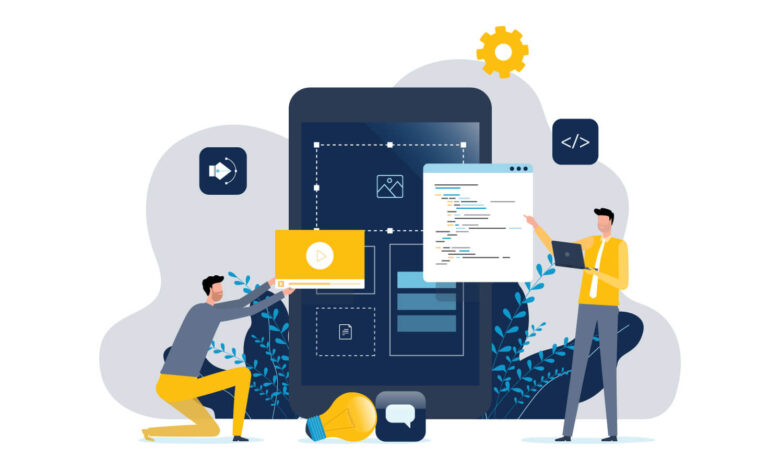From Idea to App Store : Your Mobile Development Roadmap

The journey from an idea to the app store is quite intriguing and full of innovation and strategy. With custom mobile app development services and cross-platform app development capabilities, mobile apps come into existence and reach us through the app stores.
Progressing further into 2024, the landscape of mobile app development seems promising. Mobile app development service tends to improve with the advancement in technology and changing consumer demands.
This article will serve as a basis for understanding the basics of mobile app development, its salience, and the step-by-step process involved in creating a successful mobile application.
The Foundations of Mobile App Development
Mobile app development refers to the process where a mobile app development company creates software applications that run on mobile devices, such as smartphones and tablets.
These applications are either pre-installed on devices when the manufacturing is underway or deployed as web apps through server-side or client-side processing. They tend to provide an “application-like” experience within a web browser.
An Android application development company specializes in the same mobile application development services as an iOS development company.
Salience of Mobile App Development
The significance of mobile app development lies in its ability to connect businesses with their customers seamlessly. Mobile apps provide a direct and efficient way for companies to engage with their audience, offer services, and enhance customer experience.
With over 3.8 billion smartphone users globally as of 2023, the potential reach of mobile apps is enormous and growing every passing day.
This makes them essential for businesses aiming to stay competitive and relevant. Android app development services allow companies to tap into the vast Android user base, which comprises a significant portion of the global smartphone market.
Types of Mobile Apps
Developers categorize or sort mobile apps into three main kinds:
1. Native Apps: A mobile application development company manufactures native apps for a specific operating system. It could be iOS or Android with the help of platform-specific programming languages (Swift or Kotlin/Java).
Native apps usually have a separate codebase and therefore have exceptional performance and impeccable user experience.
2. Web Apps: These are essentially responsive websites that adapt to the screen size of the device. Web apps accessible through a web browser. They are usually not installed in the device.
They are cost-effective and easy to maintain but may not provide the same level of performance and user experience as native apps. A custom app development company can help tailor these web apps to meet specific business requirements to ensure optimal functionality and user engagement.
3. Hybrid Apps: These are an unusual combination or mixture of native and web apps. They are developed using cross-platform services and web technologies including HTML, CSS, and JavaScript.
Afterwards they are draped in a native container. This allows them to be installed on devices like native apps while being easier and cheaper to develop than fully native apps. Hybrid apps possess cross-platform mobile development capabilities.
The Mobile App Development Process
Developing a mobile app involves several stages, from conceptualization to deployment and more. Here’s a detailed look at each step involved in the mobile app development process in 2024:
1. Ideation and Research
The first step in mobile app development is to brainstorm and conceptualize the app idea. This process encompasses problem identification or need realization.
The app aims to address those problems and needs. Conducting thorough market research is crucial at this stage to understand the target audience, analyze competitors, and validate the app idea.
Tools like SWOT analysis (Strengths, Weaknesses, Opportunities, Threats) can help in refining the concept and setting a clear vision for the app.
2. Defining Goals and Objectives
Once the app idea is validated, it’s important to define clear goals and objectives. What are your aims that you wish to accomplish with this app? Are you looking to increase brand awareness, generate revenue, or provide a solution to a specific problem?
Setting SMART goals (Specific, Measurable, Achievable, Relevant, Time-bound) will provide a roadmap for the development process and help in measuring success.
3. Creating a Wireframe
A wireframe is more of a blueprint that acts as a visual guide for the skeletal framework of the app. It outlines the app’s structure, user interface (UI) elements, and navigation flow.
Wireframing tools like Sketch, Adobe XD, and Sigma are widely used to create wireframes that help in visualizing the app’s design and functionality. This step is crucial for identifying potential usability issues early in the process.
4. Design and User Experience (UX)
The design phase is all about the development of an intuitive, responsive, interactive, and engaging user interface. This includes selecting color schemes and typography and designing UI elements like buttons, icons, and menus. UX design, on the other hand, ensures that the app provides a seamless and enjoyable experience for users.
User testing and feedback play a vital role in refining the design to meet user expectations.
5. Development
In the development developers come up with the code for the app. It divides into two distinct fragments:
Frontend Development: Where the user interface and experience are built is called frontend development. It involves coding the visual elements that users interact with.
Backend Development: In the backend development, developers set up the server along with database and application logic. The backend ensures that the app can handle user requests, store data securely, and perform necessary computations.
Developers use Integrated Development Environments (IDEs) like Xcode for iOS and Android Studio for Android to write and test the code.
Agile development methodologies, which involve iterative cycles of development and testing, are commonly used to ensure flexibility and responsiveness to changes.
6. Testing
Thorough testing is critical to ensure the app functions correctly and provides a smooth user experience. Multiple and diverse sorts of testing take place, including:
Functional Testing: Its purpose is to maintain and ensure the functionality of the app and its features as intended.
Usability Testing: This one is helpful in assessing the usability of the app which includes ease of use and user experience.
Performance Testing: Evaluate the app’s performance under different conditions, such as load times and responsiveness.
Security Testing: This testing identifies vulnerabilities and ensures the app is secure from potential threats.
Automated testing tools and frameworks like Appium, Selenium, and Test Complete are widely used to streamline the testing process and improve efficiency.
7. Deployment
Once the app passes all testing phases, it is ready for deployment. This involves publishing the app to app stores like Google Play Store for Android apps and Apple App Store for iOS apps. Each app store has its own set of guidelines. Each app store has its own approval processes, which must be adhered to.
Preparing marketing materials, such as app descriptions, screenshots, and promotional videos, is also essential for a successful launch.
8. Post-Launch Support and Maintenance
The development process doesn’t end with deployment. Continuous monitoring, updates, and improvements are necessary to ensure the app remains relevant and functional.
Gathering user feedback, tracking performance metrics, and addressing any issues or bugs promptly is crucial for maintaining user satisfaction and retention. Regular updates that introduce new features and enhancements keep the app competitive in the market.
Key and Upcoming Trends in Mobile App Development for 2024
As we move further into 2024, several emerging trends are shaping the future of mobile app development:
1. Artificial Intelligence and Machine Learning
AI and ML are being integrated into mobile apps to provide personalized experiences, predictive analytics, and advanced features like voice recognition and chatbots.
2. 5G Technology
The widespread adoption of 5G is enabling faster data transfer speeds and lower latency, allowing developers to create more sophisticated and responsive apps.
3. Augmented Reality (AR) and Virtual Reality (VR)
AR and VR technologies are being increasingly used in mobile apps for immersive and simulated experiences in gaming, shopping, education, and more.
4. Internet of Things (IoT)
IoT integration in mobile apps is growing, allowing users to control and interact with connected devices seamlessly.
5. Cross-Platform Development
Tools like Flutter and React Native are gaining popularity for their ability to develop apps that work on multiple platforms with a single codebase, reducing development time and costs.
Wind Up
Mobile app development could be the difference between a failing and a successful business in the digital age. Understanding the process, from ideation to post-launch support, is essential for creating successful and impactful mobile applications.
Developers can harness the full potential of mobile apps and utilize them to drive innovation, create remarkable applications, and achieve business goals in 2024 and beyond.



